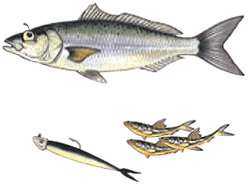Go Fishing - Port Phillip Bay

Spot 1 - Queenscliff Pier
The town of Queenscliff holds many attractions for families, tourists and holiday makers and is located on the south-western side of Port Phillip Bay. (Melway Ref: 487 A12)
- This long pier is located at the end of Symonds Street and features a large shelter shed which can provide relief from inclement weather. There is also a lower landing which can be fished from. The pier produces a variety of fish but is best known for squid.
- Fish species: Squid, yellow-eye mullet, Australian salmon, flathead, silver trevally, garfish, King George whiting
- Amenities: Ample parking (inc. disabled) at the foot of the pier, toilets, shops, cafes and grassed reserves nearby. Swimming beach adjacent to the pier.
Spot 2 - Cunningham Pier
A large attractive pier situated on the Geelong waterfront district at Western Beach which has several restaurants situated on it. (Melway Ref: 452 C2)
Provides access to deep water and can accommodate a large number of anglers. Offers year round fishing with different species available at different times.
- Fish species: Squid, Australian salmon, snapper, flathead, silver trevally, garfish, King George whiting, leatherjacket
- Amenities: Parking on and adjacent to the pier, toilets, shops, cafes and grassed reserves nearby.
Spot 3 - Werribee River
The mouth of the Werribee River is situated at Werribee South on the northern side of Port Phillip Bay. Fishing is available from a number of jetties or a long section of beach. (Melway Ref: 209 E11)
- The jetties are good platforms to fish for bream from. The sandy beach produces good-sized flathead during the warmer months and large mullet in winter. Be mindful of boat traffic in the river when fishing.
- Fish species: Bream, yellow-eye mullet, Australian salmon, flathead, silver trevally
- Amenities: Ample parking close by, toilets, boat launching facilities, seats, fish cleaning facilities, grassed reserves.
Spot 4 - Ferguson Street Pier
This pier is located at the end of Ferguson Street in Williamstown. The many moored boats in the area, together with a great view of the city over the water make it a very picturesque spot. (Melway Ref: 56 D8)
- Fishing in close around the pylons of the pier will produce bream and silver trevally whilst casting out as far as possible from the end of the pier is recommended if targeting snapper and flathead.
- Fish species: Snapper, flathead, silver trevally, Australian salmon, yellow-eye mullet, garfish, bream, rock ling
- Amenities: Adequate parking is available nearby with public toilets situated along The Strand and in Nelson Place. There are many cafes and restaurants close by and walking and cycling paths along the waterfront.
Spot 6 - Mordialloc Pier
Situated on Beach Road in Mordialloc this long pier provides a range of fishing options for different species. Mordialloc Creek which runs into the bay alongside this pier offers additional fishing opportunities. (Melway Ref: 452 C2)
- Bream and mullet can be caught in the creek year round. Autumn and winter are good times to fish the pier with a range of different species available.
- Fish species: Squid, Australian salmon, snapper, flathead, silver trevally, garfish, King George whiting, leatherjacket, bream, yellow-eye mullet
- Amenities: Ample parking, a toilet block, playground and a kiosk are all situated in the immediate area. There is also a shelter on the pier. Nearby Peter Scullin Reserve has barbeque and picnic facilities and access to the beach. Boat hire operators work out of Mordialloc Creek.
Spot 7 - Patterson River
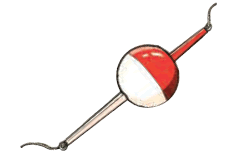
The relatively short estuary section of the Patterson River is located at Carrum. There are various access points on both sides of the river. A good starting point is to approach via Launching Way on the southern side. This gives access to various jetties, landings and sections of open bank. (Melway Ref: 97 D6)
- Australian salmon and flathead can be caught from the rock wall at the mouth of the river with bream, yellow-eye mullet, silver trevally and mulloway available further upstream.
- Fish species: Bream, yellow-eye mullet, Australian salmon, mulloway, flathead, silver trevally
- Amenities: Ample parking close by, toilets, boat launching facilities, seats, fish cleaning facilities, grassed reserves.
Spot 8 - Mornington Pier
A very popular and productive pier situated on Schnapper Point Drive in Mornington, which also acts as a breakwater for a boat harbour. (Melway Ref: 104 D9)
- Provides quality fishing all year round with summer and autumn being the best times. Options include casting into the open sea on the break wall side or fishing the lee side in quieter water. Fishing straight up and down around the pylons is also very productive.
- Fish species: Squid, Australian salmon, snapper, flathead, silver trevally, King George whiting, leatherjacket, garfish, yellowtail kingfish
- Amenities: Plenty of parking, and a toilet block and kiosk at the foot of the pier. Mornington Park is nearby and has a playground. There are two lookouts, walking trails and beaches nearby.
Spot 9 - Sorrento Pier
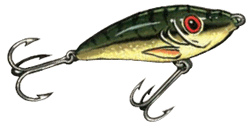
A very wide and roomy pier situated on the Esplanade at Sorrento which also incorporates the Queenscliff to Sorrento and Peninsula Searoad Ferry Terminals. (Melway Ref: 157 C7)
- Provides access to deep water however strong currents need to be considered. Can get very busy during holiday periods and weekends in the summer so try and plan a trip during the quieter times of the year.
- Fish species: Squid, Australian salmon, snapper, flathead, silver trevally, King George whiting, leatherjacket, barracouta
- Amenities: Parking and a toilet block at the foot of the pier. Cafes, shops and beaches in walking distance. Nearby Sorrento Park offers electric barbeques, picnic facilities and a playground.
Popular species
Australian salmonPeak season: March – September |
|
BreamPeak season: June – November | 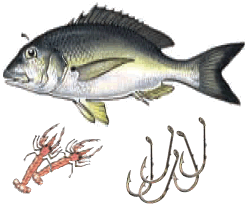 |
FlatheadPeak season: October – March | 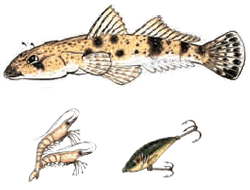 |
GarfishPeak season:November – July | 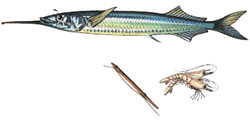 |
King George whitingPeak season: November – April | 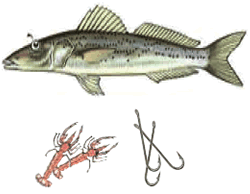 |
LeatherjacketPeak season: Year round | 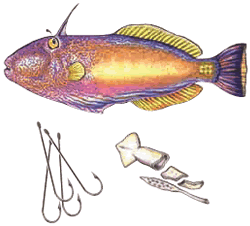 |
Silver trevallyPeak season: October – May | 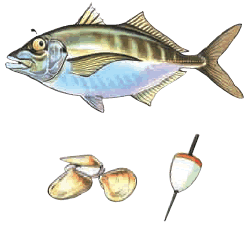 |
SnapperPeak season: October – May | 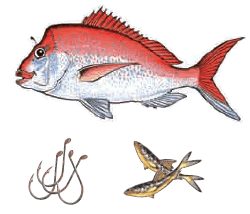 |
SquidPeak season: April – October | 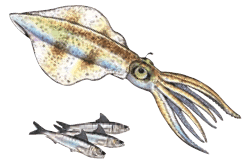 |
Yellow-eye mulletPeak season: March – September | 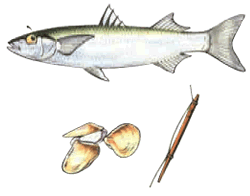 |
Understanding tides
The movements and feeding behaviour of many species of fish are strongly influenced by the rise and fall of the tide.
- High tides generally allow fish to move into areas where the water is otherwise too shallow.
- Currents caused by the rise and fall of the tide may bring food within reach of fish or allow them to feed more conveniently.
- Therefore the success of a fishing trip can depend on whether you have taken the tide into account when planning when to go.
- Information on the time of high and low tide (and height) can be found in most newspapers, fishing magazines and a variety of websites.
- Tides are caused by the gravitational pull of the moon, and to a lesser degree the sun.
- The interval between successive high tides averages out to about 12 hours and 25 minutes. Low tide occurs roughly half way in between.
- There is a greater variation in water levels between high and low tide both in late autumn and late spring.
Safety
Keep your fishing experience a safe and pleasant one by:
- being careful with hooks, lures and knives
- seeking alternatives to lead sinkers
- handling fish carefully
- being conscious of the dangers associated with water at all times
- protecting yourself against the elements
- informing someone of your trip before you go.
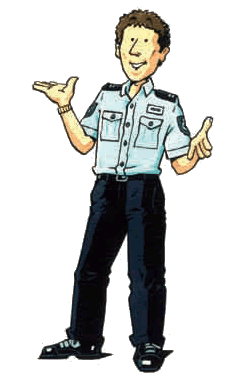
Planning a trip
Being well prepared for a fishing trip will increase your chances of success and ensure you have an enjoyable experience. Have you packed the following items?
- Suitable fishing rods
- Appropriate tackle (hooks, sinkers, swivels, floats etc.)
- Bait board and knife
- Suitable clothing (hat, waterproof clothing, footwear)
- Food and drink
- Container for bait, fish and ice if required
- Sunscreen
- Your recreational fishing licence (unless exempt)
- Seeking local advice is also recommended.
Fish by the rules
It's important to know the rules that apply to fishing. These include bag limits and minimum size limits for different types of fish. A bag limit is how many fish you are 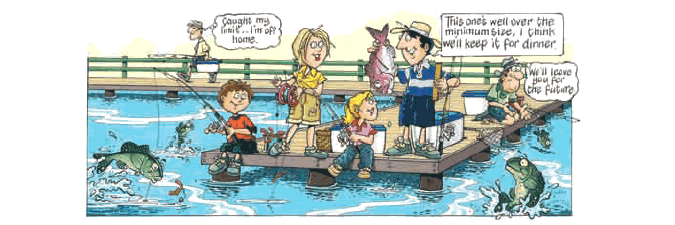 allowed to keep in one day. A minimum size limit is how big a fish needs to be in order for you to keep it. There are also closed seasons for some types of fish. To learn more get a copy of the Victorian Recreational Fishing Guide.
allowed to keep in one day. A minimum size limit is how big a fish needs to be in order for you to keep it. There are also closed seasons for some types of fish. To learn more get a copy of the Victorian Recreational Fishing Guide.

